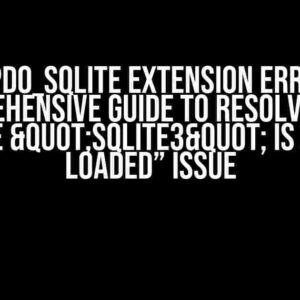Are you stuck with an error while trying to create a table using phpMyAdmin? Don’t worry, you’re not alone! Many users have faced this issue, and it’s often due to simple mistakes or misunderstandings. In this comprehensive guide, we’ll walk you through the process of creating a table using phpMyAdmin, identify common errors, and provide troubleshooting steps to fix them.
Before We Dive In…
Before we get started, make sure you have:
- phpMyAdmin installed and configured on your server
- A basic understanding of database concepts and SQL
- A clear understanding of the problem you’re facing (if you’re encountering an error)
If you’re new to phpMyAdmin or SQL, don’t worry! We’ll take it one step at a time.
Creating a Table using phpMyAdmin
Let’s start with the basics. To create a table using phpMyAdmin, follow these steps:
- Log in to your phpMyAdmin account
- Select the database where you want to create the table
- Click on the “SQL” tab
- In the SQL query box, enter the following command:
CREATE TABLE table_name (
id INT AUTO_INCREMENT PRIMARY KEY,
column1 VARCHAR(50),
column2 INT,
...
); - Replace “table_name” with your desired table name
- Replace “column1”, “column2”, etc. with your desired column names and data types
- Click the “Go” button to execute the query
That’s it! If everything goes smoothly, you should see a success message, and your table will be created.
But, what if you encounter an error? Don’t panic! Let’s identify some common errors and their solutions:
Error 1: #1046 – No database selected
Error message: “No database selected”
Solution:
- Make sure you’ve selected the correct database in the phpMyAdmin interface
- Check that you’ve specified the correct database name in your SQL query
Error message: “You have an error in your SQL syntax”
Solution:
Check your SQL query for any syntax errors, such as: - Missing closing brackets or parentheses - Incorrect data types - Duplicate column names - Typos in column or table names
Error 3: #1049 – Unknown database ‘database_name’)
Error message: “Unknown database ‘database_name'”
Solution:
- Check that the database name is spelled correctly
- Make sure the database exists and you have the necessary permissions
- Try creating the database before creating the table
Error 4: #1005 – Can’t create table ‘table_name’ (errno: 150)
Error message: “Can’t create table ‘table_name’ (errno: 150)”
Solution:
Check that the table name is not a reserved word in MySQL Check for any existing tables with the same name Try creating the table with a different name
TROUBLESHOOTING TIPS
Before we wrap up, here are some general troubleshooting tips to keep in mind:
- Always check your SQL query for syntax errors
- Verify that you have the necessary permissions and access rights
- Make sure you’re using the correct database and table names
- Check the phpMyAdmin logs for any error messages or hints
- Consult the official phpMyAdmin documentation or online resources for further assistance
| Error Code | Error Message | Solution |
|---|---|---|
| #1046 | No database selected | Select the correct database and verify the database name in the SQL query |
| #1064 | You have an error in your SQL syntax | Check the SQL query for syntax errors and correct them |
| #1049 | Unknown database ‘database_name’ | Verify the database name and ensure it exists with the necessary permissions |
| #1005 | Can’t create table ‘table_name’ (errno: 150) | Check for reserved words, existing tables, and try creating the table with a different name |
That’s it! With these steps and troubleshooting tips, you should be able to create a table using phpMyAdmin without any issues. Remember to stay calm, and don’t hesitate to seek further assistance if you’re still stuck.
CONCLUSION
Creating a table using phpMyAdmin is a relatively straightforward process, but it can be frustrating when errors occur. By following the steps outlined in this guide and troubleshooting common errors, you’ll be well on your way to becoming a phpMyAdmin master. Remember to always double-check your SQL queries, verify your database and table names, and don’t be afraid to seek help when needed.
Happy database-ing!
Frequently Asked Questions
Stuck with creating a table in phpMyAdmin? Don’t worry, we’ve got you covered! Check out these common issues and their solutions:
Why do I get a syntax error when creating a table in phpMyAdmin?
Make sure you’re using the correct syntax for creating a table. Double-check for any typos, and ensure you’re using the correct data type for each column. If you’re still stuck, try breaking down the query into smaller parts to identify the issue.
How do I fix the “Specified key was too long” error when creating a table in phpMyAdmin?
This error usually occurs when the key length exceeds the maximum allowed length. Try reducing the length of your key or use a shorter data type. You can also increase the key length by modifying the “innodb_large_prefix” and “innodb_file_format” settings in your MySQL configuration file.
Why does phpMyAdmin throw an error when I try to create a table with a foreign key constraint?
Make sure the parent table exists before creating the child table with a foreign key constraint. Also, ensure the data type of the foreign key column matches the data type of the referenced column in the parent table.
How do I troubleshoot the “Error creating table” message in phpMyAdmin?
Start by checking the phpMyAdmin error logs for more detailed information about the error. You can also try creating the table using a SQL query instead of the GUI. Additionally, ensure that you have the necessary permissions to create tables in the selected database.
Can I create a table in phpMyAdmin using a SQL query?
Yes, you can create a table in phpMyAdmin using a SQL query. Simply navigate to the SQL tab, enter your CREATE TABLE query, and click the “Go” button. This method can be helpful when you need more control over the table creation process or when you’re experiencing issues with the GUI.




![Mysqli Errors on PHP 8.2 Despite it Being Loaded [Closed]: A Comprehensive Guide to Troubleshooting Mysqli Errors on PHP 8.2 Despite it Being Loaded [Closed]: A Comprehensive Guide to Troubleshooting](https://rubio.hkhazo.biz.id/wp-content/uploads/sites/91/2024/07/mysqli-errors-on-php-8-2-despite-it-being-loaded-closed-a-comprehensive-guide-to-troubleshooting-with-text-300x300.jpg)